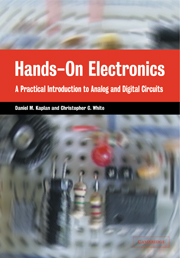Book contents
- Frontmatter
- Contents
- List of figures
- List of tables
- About the authors
- To the Reader
- Acknowledgments
- Introduction
- 1 Equipment familiarization: multimeter, breadboard, and oscilloscope
- 2 RC circuits
- 3 Diodes
- 4 Bipolar transistors
- 5 Transistors II: FETs
- 6 Transistors III: differential amplifier
- 7 Introduction to operational amplifiers
- 8 More op amp applications
- 9 Comparators and oscillators
- 10 Combinational logic
- 11 Flip-flops: saving a logic state
- 12 Monostables, counters, multiplexers, and RAM
- 13 Digital↔analog conversion
- Further reading
- Appendix A Equipment and supplies
- Appendix B Common abbreviations and circuit symbols
- Appendix C RC circuits: frequency-domain analysis
- Appendix D Pinouts
- Glossary of basic electrical and electronic terms
- Index
12 - Monostables, counters, multiplexers, and RAM
Published online by Cambridge University Press: 06 July 2010
- Frontmatter
- Contents
- List of figures
- List of tables
- About the authors
- To the Reader
- Acknowledgments
- Introduction
- 1 Equipment familiarization: multimeter, breadboard, and oscilloscope
- 2 RC circuits
- 3 Diodes
- 4 Bipolar transistors
- 5 Transistors II: FETs
- 6 Transistors III: differential amplifier
- 7 Introduction to operational amplifiers
- 8 More op amp applications
- 9 Comparators and oscillators
- 10 Combinational logic
- 11 Flip-flops: saving a logic state
- 12 Monostables, counters, multiplexers, and RAM
- 13 Digital↔analog conversion
- Further reading
- Appendix A Equipment and supplies
- Appendix B Common abbreviations and circuit symbols
- Appendix C RC circuits: frequency-domain analysis
- Appendix D Pinouts
- Glossary of basic electrical and electronic terms
- Index
Summary
This chapter will introduce a variety of techniques that are important in sequential-logic design. Such designs often make use of pulses of various durations. Sometimes a logic pulse of a given width needs to be formed in response to a particular input condition, e.g. to standardize a pulse from a push-button. Monostable multivibrators are the usual solution. In addition to monostables of a given logic family (such as the 74121, ‘122, ‘123, etc.), there are also available the family of timer chips (such as the 555); the latter are particularly useful when a long pulse of stable and reproducible width is needed.
In this chapter you will also explore counters and their uses in timing and addressing. As an example of the use of an address counter, you will store and retrieve information in a small memory chip.
Be sure to write down the circuit's schematic, with pin numbers, for every circuit you build. You will find the schematic especially useful should your circuit not work. A simple review of the schematic will often reveal the source of the problem. Further more, a schematic is essential when debugging subtle errors.
Apparatus required
Breadboard, oscilloscope, 7400 NAND, two 7490 and one 7493 counter, 74121 (or similar) one-shot, 74150 multiplexer, 7489, 74189, or 74219 RAM chip, two TIL311 displays, assorted resistors and capacitors.
- Type
- Chapter
- Information
- Hands-On ElectronicsA Practical Introduction to Analog and Digital Circuits, pp. 155 - 166Publisher: Cambridge University PressPrint publication year: 2003

